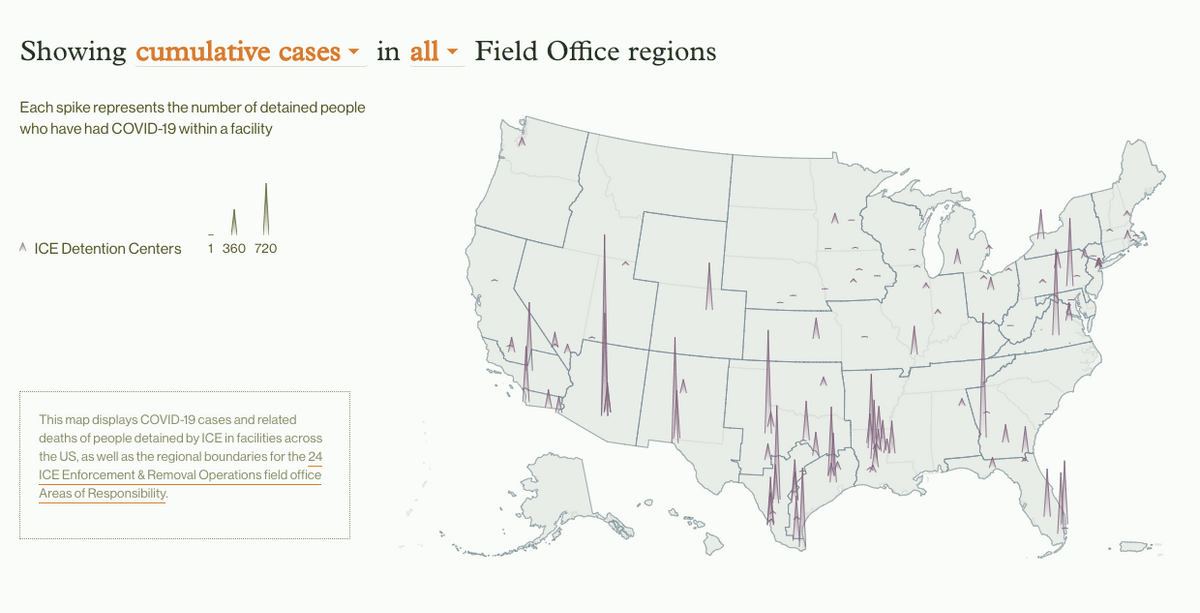March 25th, 2021 • Ishan Nagpal, Theresa Cheng, and Joshua Manson
Data Project Adds ICE Detention Page to its Website

The UCLA Law COVID Behind Bars Data Project has added a new interactive map to its website presenting data on COVID-19 among people held in immigration detention by U.S. Immigration and Customs Enforcement (ICE).
This new ICE Detention page displays the numbers and rates of active and cumulative cases and deaths among the more than 130,000 people who have been held in ICE custody during the pandemic. The data cover more than 120 federal, state, and local facilities — including dedicated detention centers, prisons, and jails — holding people detained by ICE. These facilities can be viewed individually and filtered by ICE Field Office region.
Since the start of the pandemic, ICE facilities, much like prisons and jails across the country, have been highly effective incubators of COVID-19. According to the data, more than 10,000 people held in immigration detention have been infected with COVID-19 and at least ten have died.
The true numbers are likely much higher, but ICE’s reporting practices leave the public in the dark as to how effectively ICE is detecting cases. Infection data is only as reliable as a testing regime is robust, but ICE reports only the total number of people who have ever been tested for COVID-19 across its entire system, not how many times those people were tested, or where tests were administered.
Without knowing the frequency of testing, it is impossible to tell whether the agency has been conducting screening testing — as recommended by CDC guidelines — or merely diagnostic testing of those already with symptoms of exposure to COVID-19. Because the data are not facility-specific, it is impossible to assess whether the reported case rate at a particular location captures the scale of the outbreak occurring there.
There is good reason to be skeptical. In June, the Vera Institute of Justice built an epidemiological model estimating that the number of people in ICE custody who have had COVID-19 may be up to fifteen times higher than the number reported by ICE.
And in at least one documented instance, ICE has deliberately restricted the availability of testing during the height of an outbreak because of its own limited quarantine capacity.
Like those held in jails and prisons, people held in ICE custody have been denied the ability to take basic protective measures against the virus despite being forced to live in congregate settings. A report by Physicians for Human Rights found that nearly all detainees interviewed were unable to socially distance. Nearly half lacked access to soap at some point.
Last week, a group of Senators introduced the COVID-19 Data Collection in Immigration Detention Facilities Act, a bill that would dramatically improve data collection and reporting by ICE and other immigration agencies. Among other measures, it would require that ICE, U.S. Customs and Border Protection (CBP), and the Office of Refugee Resettlement (ORR) report certain detailed COVID-19 data to both the CDC and to the public on their websites. If passed, the bill would shine much needed light on the pandemic in ICE detention.
next post
March 30th, 2021 • Erika Tyagi, Liz DeWolf, and Joshua Manson
Two Months (And Counting) Without Critical COVID-19 Data from Pennsylvania Prisons
In January, the Pennsylvania Department of Corrections removed its data dashboard due to “technical challenges.” More than two months later, we’re still missing critical data.